The Moon alphabet
The moon alphabet (the Moon Code) was developed in 1845 by Dr. William Moon
and is as a tactile alphabet the most well-known relief writing for the blind.
The font consists of simple geometric symbols whose

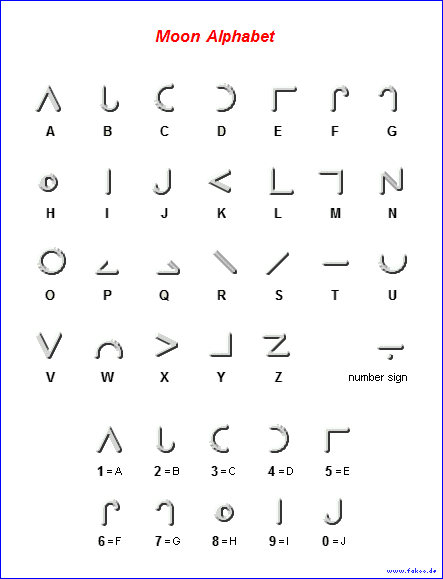
---------- Moon Alphabet: ----------
A = two straight lines form an open angle
B = vertical straight line followed by a bow below right
C = semicircle, opening on the right
D = semicircle, opening on the left
E = vertical and horizontal straight lines form an angle open to the bottom right
F = vertical straight line followed by a bow on the top right (walking stick)
G = vertical straight line followed by a bow at the top left
H = small full circle, half filled
I = a vertical straight line
J = vertical straight line followed by a curve at the bottom left
K = two straight lines form an angle open to the right
L = vertical and horizontal lines form an angle open to the right
M = vertical and horizontal lines form an angle open to the left below
N = vertical zig-zag line starting at the bottom left and ending at the top right
O = full circle
P = horizontal straight line with a small acute angle upwards at the left end
Q = horizontal straight line with a small acute angle upwards at the right end
R = oblique line from top left to bottom right
S = oblique line from bottom left to top right
T = a horizontal straight line
U = semicircle, opening at the top
V = two straight lines form an upwardly open angle
W = semicircle, opening at the bottom
X = two straight lines form an angle open to the left
Y = vertical and horizontal lines form an angle open to the left above
Z = horizontal zig-zag line beginning at top left and ending at bottom right
------------------------------------------
Full print version of the Moon alphabet as text output (new window)
to the top
|
---------- Table Dotty-Moon Code: ----------
[Numbers behind the d in parentheses are occupied dots according to the following scheme:
(column1) (column2) (column3) (column4) (column5)
Line 1: [1] [1] [1] [1] [1]
Line 2: [2] [2] [2] [2] [2]
Line 3: [3] [3] [3] [3] [3]
Line 4: [4] [4] [4] [4] [4]
Line 5: [5] [5] [5] [5] [5]
Each character consists of 5 rows of 5 columns each.
The dots are so close that they can not be felt individually.
(Punkte spaltenweise!)
Character A = d 45 + d 23 + d 1 + d 23 + d 45
Character B = d 1234 + d 5 + d 5 + d 5 + d 4
Character C = d 234 + d 15 + d 15 + d 15 + d 15
Character D = d 15 + d 15 + d 15 + d 15 + d 234
Character E = d 12345 + d 1 + d 1 + d 1 + d 1
Character F = d 2345 + d 1 + d 1 + d 1 + d 2
Character G = d 2 + d 1 + d 1 + d 1 + d 2345
Character H = d 34 + d 2345 + d 25 + d 34 + d -
Character I = d - + d - + d 12345 + d - + d -
Character J = d 4 + d 5 + d 5 + d 5 + d 1234
Character K = d 3 + d 24 + d 24 + d 24 + d 15
Character L = d 12345 + d 5 + d 5 + d 5 + d 5
Character M = d 1 + d 1 + d 1 + d 1 + d 12345
Character N = d 2345 + d 2 + d 3 + d 4 + d 1234
Character O = d 234 + d 15 + d 15 + d 15 + d 234
Character P = d 45 + d 35 + d 5 + d 5 + d 5
Character Q = d 5 + d 5 + d 5 + d 35 + d 45
Character R = d 1 + d 2 + d 3 + d 4 + d 5
Character S = d 5 + d 4 + d 3 + d 2 + d 1
Character T = d 3 + d 3 + d 3 + d 3 + d 3
Character U = d 234 + d 5 + d 5 + d 5 + d 234
Character V = d 12 + d 34 + d 5 + d 34 + d 12
Character W = d 345 + d 2 + d 2 + d 2 + d 345
Character X = d 15 + d 24 + d 24 + d 24 + d 3
Character Y = d 5 + d 5 + d 5 + d 5 + d 12345
Character Z = d 1 + d 145 + d 135 + d 125 + d 5
------------------------------------------
Complete print version of the Dotty-Moon Alphabet as text output (new window)
to the top
|
But fluent reading is not possible and for writing by hand, the Moon
The old books in Moon Writing font have a peculiarity: the

Although the Moon Alphabet was invented
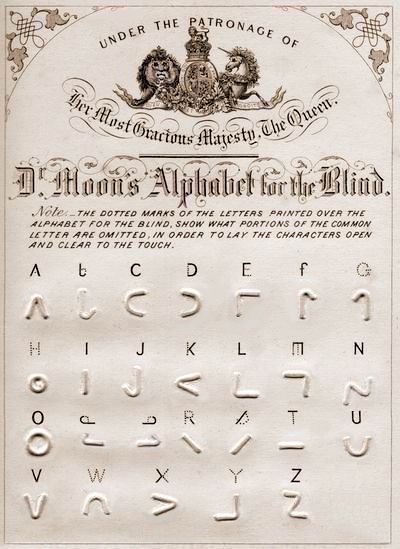
The characters of the Moon alphabet are partly similar to Latin letters.
Written with a stencil and reversed on a foil, alternatively there are
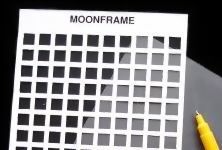
With the blind-typewriter Moon-Writer (invented only in 1986)
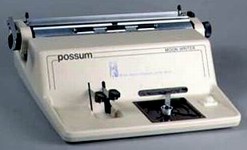
How do you use the Moonwriter?
In modern times, too, Moon is used for rehabilitation (e.g.,
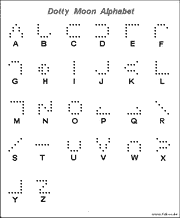
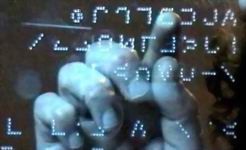
The Moon alphabet is mainly intended for reading, but only printed material

Here is a sample in moon writing:
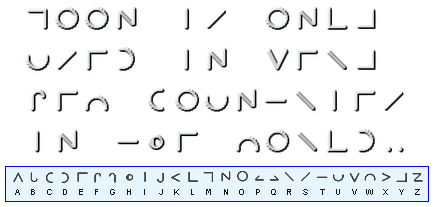
For the tactile operation of an iPhone,

Exercises:
 here you can create and print your own moon texts
here you can create and print your own moon texts
 encrypt or decode the dot versions of Moon
encrypt or decode the dot versions of Moon
Further information:
look also
 Development of the writings for the blind
Development of the writings for the blind
TTF Font:

Here you will find different Moon fonts.
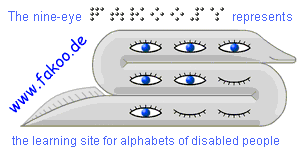
Alternatives to the well-known Moon alphabet (by Alexander Fakoó):

Quadoo
An alternative for handwritten notes would be the

For this writing, it is possible to use the 'Moon Writer' or to write
Fakoo
A good alternative to the Moon alphabet

However, it was not taken into account that reduction rules were also
Siekoo
Another alternative would

The Siekoo alphabet has the advantage that it is easy to learn and
Moon-9
For the use of the Moon writing with braille technique,

print versions of Moon-9 Alphabet and the text version

The text READ IN MOON on a braille display in Moon


 More information about the Moon Alphabet can be found at
More information about the Moon Alphabet can be found at